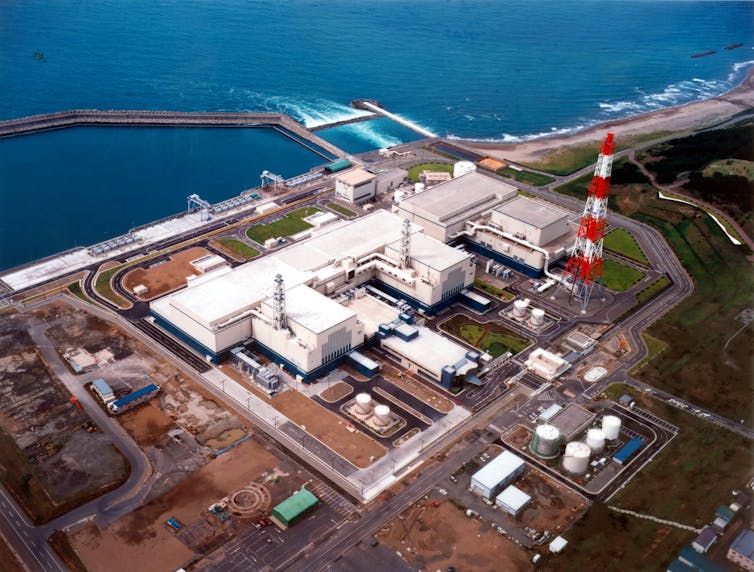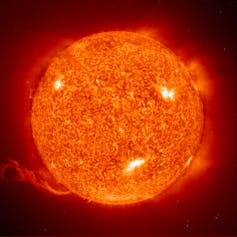
Globally, nuclear power accounts for roughly 10% of electricity generation. In some countries, such as France, this figure is nearly 70%.
Big tech companies such as Google are also turning to nuclear power to meet the huge power demands of their data centres.
The source of all nuclear power is the binding energy of an atom. The energy stored in an atom can be released in two main ways: fission or fusion. Fission involves splitting big heavy atoms into smaller, lighter ones. Fusion involves combining little atoms together into bigger ones.
Both processes release a lot of energy. For example, one nuclear fission decay of U235, an isotope of uranium typically used as the fuel in most power plants, produces more than 6 million times the energy per single chemical reaction of the purest coal. This means they are great processes for generating power.
What is fission?
Fission is the process behind every nuclear power plant in operation today. It occurs when a tiny subatomic particle called a neutron is slammed into an uranium atom, splitting it. This releases more neutrons, which continue colliding with other atoms, setting off a nuclear chain reaction. This in turn releases a tremendous amount of energy.
To convert this energy to electricity a heat exchanger is installed, which turns water to steam, driving a turbine to produce power.
The fission reaction can be controlled by suppressing the supply of neutrons. This is achieved by inserting “control rods” which soak up neutrons. Historically, nuclear accidents such as Chernobyl have occurred when the control rods fail to engage and quench the neutron supply, and/or coolant circulation fails.
So called “third generation” designs improve on early designs by incorporating passive or inherent safety features which require no active controls or human intervention to avoid accidents in the event of malfunction. These features may rely on pressure differentials, gravity, natural convection, or the natural response of materials to high temperatures.
The first third generation reactors were the Kashiwazaki 6 and 7 advanced boiling water reactors in Japan.

An unresolved challenge for fission is that the byproducts of the reaction are radioactive for a long time, in the order of thousands of years. If reprocessed, the fuel source and waste can also be used to make a nuclear weapon.
Fission power is a demonstrated technology. It is also scalable from large scale (the largest is the 7.97 gigawatt Kashiwazaki-Kariwa Nuclear Power Plant in Japan) through to small-to-medium reactors that produce around 150 megawatts of electricity, as used on a ship or nuclear submarine. These are the reactors that will power Australia’s eight nuclear submarines promised as part of a trilateral security partnership with the United Kingdom and the United States.
What is fusion?
Fusion is the process that powers the Sun and stars. It is the opposite process to fission. It occurs when atoms are fused together.
The easiest reaction to initiate in the laboratory is the fusion of isotopes of hydrogen, deuterium and tritium. Per unit mass, the reaction produces 4 times more energy than the fission of U235.
The fuel ion deuterium is incredibly abundant on Earth and in the universe. Tritium is radioactive with a half-life of 12 years, so is very rare on Earth. The universe is 13.8 billion years old; the only isotopes of light nuclei (hydrogen, helium and lithium) found in nature are those that are stable on those time scales.
In a fusion power plant, tritium would be manufactured using a “lithium blanket”. This is a solid lithium wall in which fusion neutrons slow and ultimately react to form tritium.
However, at present it’s very difficult for scientists to create a fusion reaction outside of the laboratory. That’s because it requires incredibly hot conditions to fuse: the optimal conditions are 150 million degrees Celsius.

At these temperatures the fuel ions exist in the plasma state, where electrons and (nuclear) ions are dissociated. The byproduct of this process isn’t radioactive; rather, it’s helium, an inert gas.
The leading technology path to demonstrate sustained fusion is called “toroidal magnetic confinement”. This is when the plasma is confined at extreme temperatures in a very large doughnut-shaped magnetic bottle.
Unlike fission, this technology path requires continuous external heating to reach fusion conditions and a strong confining field. Terminate either and the reaction stops. The challenge is not uncontrolled meltdown, but getting the reaction to occur at all.
A major unresolved challenge for toroidal magnetic confinement fusion, which attracts the majority of research interest, is the demonstration of a burning self-heated plasma. This is when the heating power produced by the reaction itself is primary. This is the objective of the publicly funded multi-national ITER project, the world’s largest fusion experiment, and the privately funded SPARC experiment at Massachusetts Institute of Technology.
However, the consensus of much of the scientific community is that fusion will not be commercially viable until at least 2050.
A climate solution?
I am often asked if nuclear power could save Earth from climate change. I have many colleagues in climate science, and indeed my late wife was a high-profile climate scientist.
The science is clear: it is too late to stop climate change. The world needs to do everything it can to reduce carbon dioxide emissions and minimise catastrophic damage, and it needs to have done it decades ago.
For the planet, fission is part of that global solution, together with widespread rollout and adoption of renewable sources of power such as wind and solar.
On a longer time scale, one hopes that fusion might replace fission. The fuel supply is much larger and ubiquitously distributed, the waste problem is orders of magnitude smaller in volume and timescale, and the technology cannot be weaponised.
Matthew Hole receives funding from the Australian government through the Australian Research Council and the Australian Nuclear Science and Technology Organisation (ANSTO), and the Simons Foundation. He is also affiliated with ANSTO, the ITER Organisation as an ITER Science Fellow, and is Chair of the Australian ITER Forum.
This article was originally published on The Conversation. Read the original article.




!["[T]he First and Fifth Amendments Require ICE to Provide Information About the Whereabouts of a Detained Person"](https://images.inkl.com/s3/publisher/cover/212/reason-cover.png?w=600)


